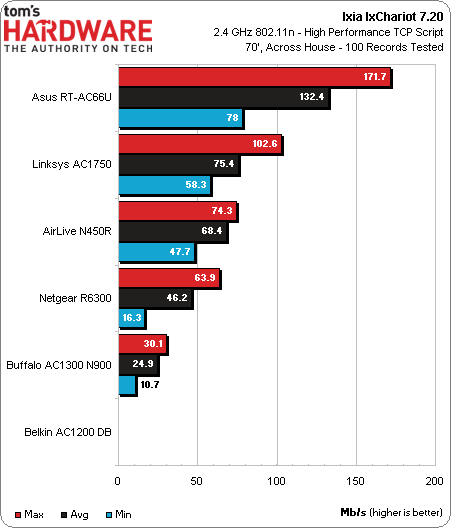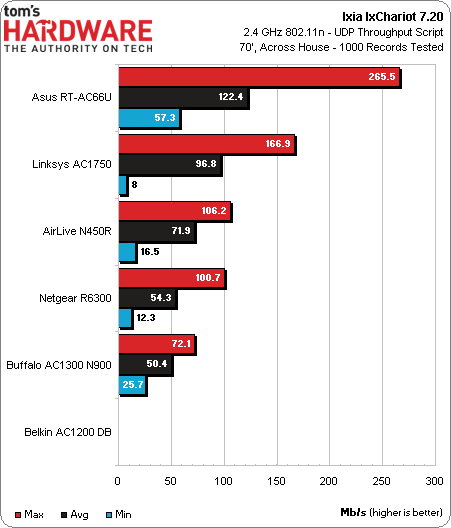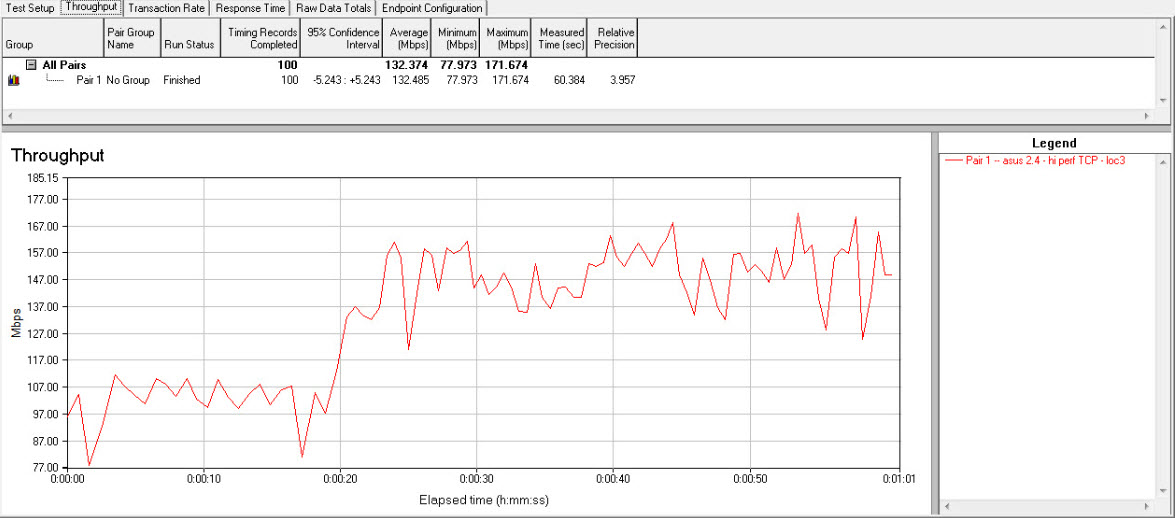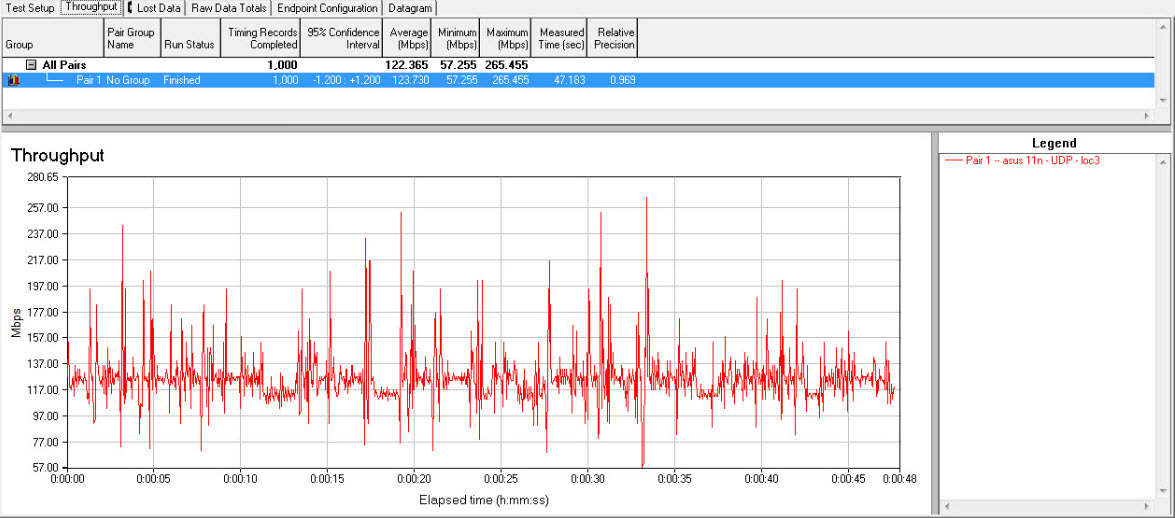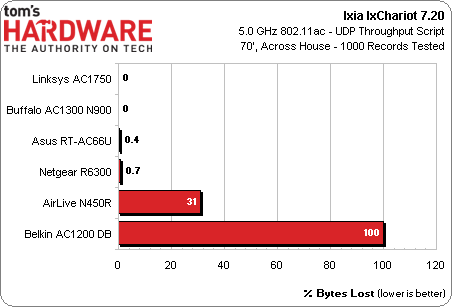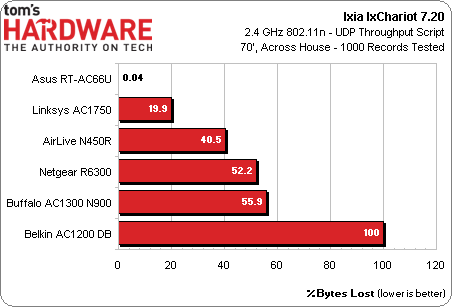Gigabit Wireless? Five 802.11ac Routers, Benchmarked
Five years ago, we didn't have homes with a dozen wireless nodes and the need to run HD video to multiple screens. Today we do. Our 802.11n networks, especially on the 2.4 GHz band, are swamped. Can 802.11ac save the day? We test six routers to find out.
Results: IxChariot, Across-House, 2.4 GHz
Why you can trust Tom's Hardware
We’ll move quickly through the 2.4 GHz cross-house tests as these results largely repeat what we’ve observed previously.
Again, AirLive and Asus prove their strength in TCP testing through their minimum throughput times. AirLive in particular shows a narrow delta between minimum and maximum results, which is good. Of all the routers here, Asus emerges as the easy victor on this test, with Linksys coming in a distant second.
With UDP traffic, the story repeats. Asus is the only router we’d trust with a high-def stream, although we’d settle for the Buffalo in a pinch.
The difference in data patterns between our two traffic types can be striking. With 1,000 records passed using UDP, compared to 100 for TCP, one gets a better sense of where the “normal” bandwidth of UDP rests. In contrast, TCP seems much more meandering and variable.
One cool feature within IxChariot is its automatic report of how many bytes of data are lost in a given UDP communication. This is something you generally don’t see reflected in speed results. Does it matter if you see 200 Mb/s performance if only half of your data shows up? Maybe, depending on the application. This is why we took some of our long-distance data and broke out the bytes lost into separate charts.
Belkin scores 100% loss because it wouldn’t connect at this range. While not technically accurate since there was no actual data transmission, we felt it important to visually represent a worst-case.
The difference between 5.0 and 2.4 GHz is remarkable. Now we see AirLive’s adherence to prior-gen 11a, even with the assistance of beamforming, start to become a serious obstacle. Buffalo and Linksys have zero loss under 11ac, which is phenomenal.
Our situation reverses with 2.4 GHz. Buffalo and Netgear drop over half of their packets, and AirLive isn’t far behind. Only Asus manages nearly flawless reliability. This should be of particular note to users who anticipate using clients on both radio bands.
Current page: Results: IxChariot, Across-House, 2.4 GHz
Prev Page Results: IxChariot Next Page 802.11ac: A Substantial Step Up From 802.11nGet Tom's Hardware's best news and in-depth reviews, straight to your inbox.
-
boulbox Well, i can't wait until i can make my router give wifi all the way to my to my work area.(only a few blocks away)Reply -
I've tested both the R6300 and the RT-AC66U in my home. The R6300 beats it hands down. The average homes won't have the traffic that your artificial software creates. Even your tests show that R6300 in 5ghz mode is faster. People will buy these for gaming and HD movie viewing and the R6300 has better range as well. I've paired my R6300 with an ASUS PCE-AC66 desktop wireless AC adapter and I can acheive 30 MB/S (megabytes) to my HTPC in a 2 story house. That's an insane speed. The RT-AC66U only managed about 15 to 18 MB/s. Also make sure the R6300 has the latest firmware, which is V1.0.2.38_1.0.33. But in conclusion, the R6300 and the RT-AC66U are like a SRT Viper and ZR1 Vette. They are both great pieces of hardware to fit most users needs. Get the ASUS If you got a ton of traffic and a lot of 2.4 ghz devices. Grab the R6300 if you are looking for a friendly setup, max speed, and max range.Reply
-
fwupow Man it sure sucks when you type a long comment and it gets vaporized cuz you weren't logged in.Reply -
DeusAres I'd be happy with a 2Mb/s connection. It'd be better than this horrible 512 Kb/s connection I have now. At least then, I may actually be able to watch youtube vids in 360p.Reply -
fwupow Here's the gist of what I typed before it was rudely vaporized.Reply
I have a dual-band router (Netgear N600). I also purchased a couple of dual-band client USB adapters Linksys AE2500 or something to that effect.
So the USB adapter works fine for a desktop, but having that crap sticking out the side of a laptop, netbook or tablet? Busted in 10 minutes. I hooked one up to my netbook and fried it within a couple of weeks because I'm a Netbook in bed guy. You wouldn't think it could get so hot from a USB port but it does.
So the reality is that you have all these devices that can't be upgraded to dual-band and enjoy very little if any benefit from the new-fangled dual-band router.
The other beef I have with routers is that they're terrible with the way they split up bandwidth between multiple devices. Instead of responsively reassigning bandwidth to the device that needs it, the router continues to reserve a major slice for a device that I'm not using.
If you live in an apartment building, it's actually rather rude to use the full 300Mbps capacity of the wireless N band, since you may well succeed in effectively shutting your neighbor down. There's so much happening in the 2.4GHz band nowadays, it's unreal. Your own cordless keyboards/mice/controllers etc can malfunction from being unable to get a packet in edgewise.
For these dual-band routers to be really useful, we need manufacturers of smartphones, tablets, laptops, netbook and such to build dual-band clients into them because adding the functionality with some sort of dongle just doesn't work. -
memadmax I was a 802.11g and n "adoption" tester....Reply
Never again...
I'll give ac a year or two before I jump on it... -
SteelCity1981 my wireless N produces 300 Megabits which would equal around 37 Megabytes. My highspeed internet doesn't come cloe to reaching 37 megabytes and i don't transfer tons of files wirelesly and my wi-fi rangs is pretty good .So i'm perfectly fine with my 300MB N wireless router right now. Besides that none of my devices spport ac anyhow so it would get bottlenecked from reaching its full potential.Reply -
chuckchurch iknowhowtofixit"Folks, the time to start your 802.11ac adoption is now."I think this review proved that it is time to wait for 2nd generation wireless AC routers to appear before rushing to purchase.Reply
Exactly. The 'client' adapter they used if anyone didn't catch it was a Cisco/Linksys router-sized device. Not practical by any means. It'd be totally insane to make any product recommendations prior to real client adapters being available, or more accurately, embedded ones are available. I think a wireless salesman wrote this article.
